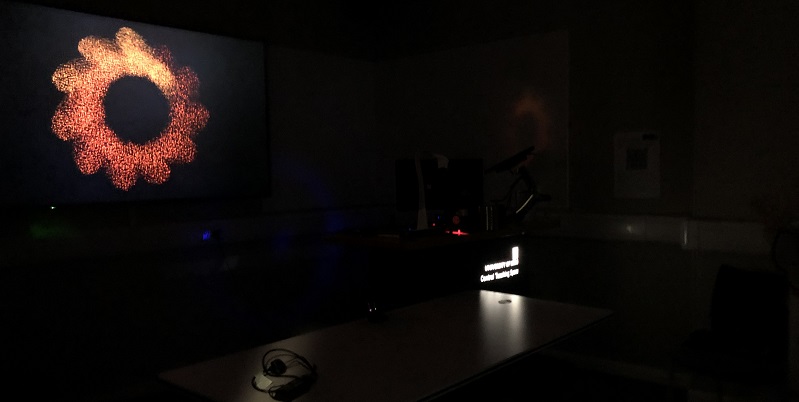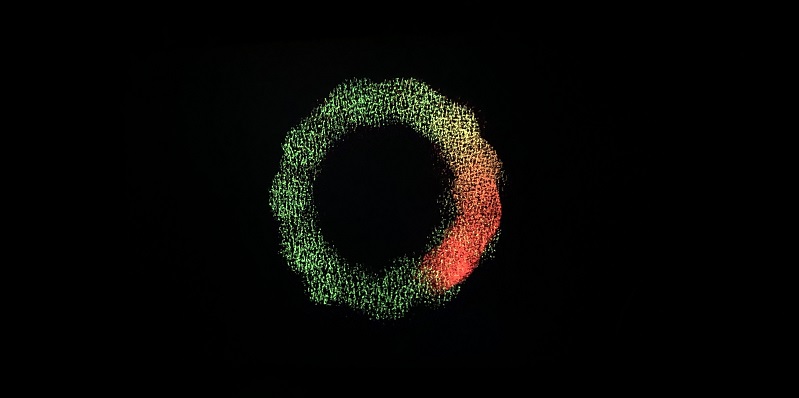Communicating climate change through interactive art

Gabi Kiryluk, Digital Media student, recently completed her final year research project which utilised digital media to explore how artwork can provide more visceral experiences of climate science.
The Loops for Stagnation installation was visited by staff and students during Climate Week and the Student Sustainability Research Conference. It brought attention to the everyday interactions we have with the campus environment whilst acting as a Living Lab on climate communication.
The research responds to the following two questions:
- Is the digital artwork 'Loops for Stagnation' an effective way to communicate the climate crisis?
- How does the pre-existent level of understanding and knowledge of climate change/ sustainability shape the way people respond to the installation?
Find out more about how the installation was developed using visual programming software or read on to hear about the results.
How can digital interactive art make us understand climate change differently?
86% (n=26) of participants expressed that in their view the installation is an effective way to communicate climate change. Respondents most frequently highlighted that the installation made them reflect on the impact they have on the wider climate system. Some participants reported that the effectiveness of the installation lies in the fact that you get to learn about the issue without being bombarded with a lot of information, but you are rather encouraged to grasp it through interactive experience.
14% (n=4) of participants expressed doubts about the effectiveness of the experience as a way to communicate climate change; two of which self-reported little understanding of climate change. By interacting with the artwork, they understood that they can impact the climate and that their actions have influence and considered it to be an interesting way to talk about climate change, but felt like they needed more time to understand it. The other two participants reported that they felt like the link between the artwork and climate change is not intuitive and that the accompanying information is necessary to make that link.
How do pre-existing levels of climate change knowledge shape how people respond to the installation?
Out of all participants who responded to the survey (n=30), 2 participants self-reported a low level of understanding of climate change, 5 participants self-reported as having a good level of understanding and 23 participants self-reported as having a great level of understanding of climate change.
Little understanding of climate change: this group of respondents emphasised that the artwork is interesting and that they enjoyed the concept of it, but felt like they needed more time to understand it. For some it appeared more as an art installation rather than a climate change educational piece.
Good understanding of climate change: the artwork made this group of respondents reflect on the impact that their actions have on a wider climate system. In their responses they highlighted the enjoyability and innovativity of the experience. One respondent stated that it has helped them "reconsider things about climate change in a fun and inviting way than the usual overload of information on the issue". Another respondent reported that the experience felt like a reset or reconsideration: “It lacks some of the polarising and binary arguments that proliferate the topic of climate change, and instead offers non-judgmental thought and reflection. This somewhat removes some of the preconceived notions, fears etc and instead allows for a more singular experience.”
Great understanding of climate change: some of the most commonly identified themes amongst the responses from this group were the impact and influence of their actions that the installation allowed them to reflect on. They reported that they felt a connection with the Loop and highlighted a reflective character of the artwork. Some participants pointed out that not enough factual information has been given about the similarities between the Loop and climate change and that they would have liked to see more prompts around the space to make that link easier. Respondents frequently found the experience to be engaging and stimulating.
Read the full report about how Loops for Stagnation was experienced.

Keep up to date on the latest news
-
- Follow us on Twitter: @UoL_Sus
- Follow us on Instagram: @uol_sus
- Follow us on Facebook: @UoLSustainability
- Sign up to our Sustainability newsletter
United Nations Sustainable Development Goals
 We use the United Nations Sustainable Development Goals (SDGs) as a framework to guide our activity. Our work on Student Citizenship links to all of the SDGs.
We use the United Nations Sustainable Development Goals (SDGs) as a framework to guide our activity. Our work on Student Citizenship links to all of the SDGs.
Find out more about our impact on the SDGs.
